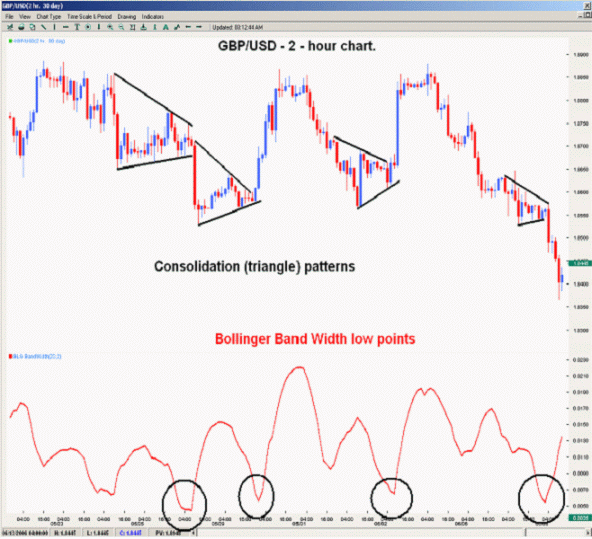Bollinger Band Width And Trading Ranges:
When To Trade And When To Fade
The market enjoys two basic trading
conditions which tend to repeat on a very
regular basis; range bound and trending states.
As buyers and sellers establish the extreme
overbought and oversold regions, these two
opposing forces begin to approach one another,
and a trading range develops as relative support
and resistance levels begin to approach one
another. This phenomenon often times takes the
shape of a triangle consolidation pattern.
Eventually either the buying or selling side
takes control, forcing the opposition into
submission as a new trend develops and as the
market trades at new highs or lows. Once this
trend exhausts itself and the market fails to
accomplish new highs or lows, a new range will
now develop.
As the market continues to cycle between
trending and ranging conditions the Bollinger
Bands will continue to expand and contract based
on its relative states of volatility. During
trending markets the Bollinger Band Width
indicator tends to rise as the bands that it
measures expand away from each other. On the
same note, when a range bound condition ensues
the Bollinger Band Width line tends to fall as
the bands contract once again towards one
another. Although there may not be a notional
value to gauge low or high extremes of the
Bollinger Band Width line, we can approximate
the ultimate high and low points by simply
noting recent trading activity on the chart.
More importantly we should note the direction of
the Width line, as it falls after visiting
extreme highs, or rises after touching extreme
lows.
Now the question remains, how can we use this
in our day to day trading operations? Very
simply, we can see the following 2-hour chart,
the GBP/USD has formed and subsequently broken
out of a number of triangle patterns as the
Bollinger Band Width line rises and falls
respectively. As a triangle develops, we may
choose to go long near support and sell short
near resistance, and we may continue to do so
profitably until the Width line falls to an
extreme low, and then reverses to the upside. On
the same note, in a trending market, we may
choose to buy new highs, or sell new lows until
the Width line touches an extreme high, and then
reverses to the downside. Although the notional
value of the Width line is important to note,
the current direction of this line may be more
helpful in showing us the future implied state
of volatility and therefore dictate the next
trade in our near future. Note how each triangle
finally breaks into a new trend just as the
Width line reaches an extreme low and reverses
to the upside (circled below). This is typically
considered the inflection point where a range
becomes a trend and our view on the market must
change accordingly.
 |